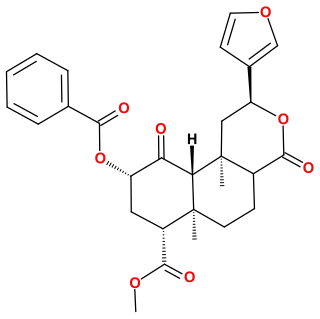Diterpenes are a class of chemical compounds composed of four isoprene units, often with the molecular formula C20H32. They are biosynthesized by plants, animals and fungi via the HMG-CoA reductase pathway, with geranylgeranyl pyrophosphate being a primary intermediate. Diterpenes form the basis for biologically important compounds such as retinol, retinal, and phytol. They are known to be antimicrobial and antiinflammatory.

Tripterygium wilfordii, or léi gōng téng (Mandarin), sometimes called thunder god vine but more properly translated thunder duke vine, is a vine used in traditional Chinese medicine.

Herkinorin is an opioid analgesic that is an analogue of the natural product salvinorin A. It was discovered in 2005 during structure-activity relationship studies into neoclerodane diterpenes, the family of chemical compounds of which salvinorin A is a member.

Tripterygium is a genus of plants in the family Celastraceae. Tripterygium wilfordii is used in Traditional Chinese medicine.

Kahweol is a diterpenoid molecule found in the beans of Coffea arabica. It is structurally related to cafestol. It gets its name from the Arabic word "Ka-ah-wa", from which "coffee" derives. In French, it's evolved into the slang word "kawa", to designate coffee.

Tripterygium regelii, or Regel's threewingnut, is a rambling, shrubby perennial deciduous yellow vine native to Korea, Japan and Manchuria. It grows to about 200 centimetres (79 in). Small very pretty yellowish white or white flowers appear in May–June and are produced on 203–229 millimetres (8.0–9.0 in). long panicles, and smell somewhat of new-mown hay. Fruits are greenish white, 3-angled, and winged.
"Tripterygium wilfordii Hook.f., known as Leigongteng in traditional Chinese medicine, has attracted much attention for its applications in relieving autoimmune disorders such as rheumatoid arthritis and systemic lupus erythematosus, and for treating cancer. Molecular analyses of the ITS and 5S rDNA sequences indicate that T. hypoglaucum and T. doianum are not distinct from T. wilfordii, while T. regelii should be recognized as a separate species. The results also demonstrate potential value of rDNA sequence data in forensic detection of adulterants derived from Celastrus angulatus in commercial samples of Leigongteng."

A quinone methide is a type of conjugated organic compound that contain a cyclohexadiene with a carbonyl and an exocyclic methylidene or extended alkene unit. It is analogous to a quinone, but having one of the double bonded oxygens replaced with a carbon. The carbonyl and methylidene are usually oriented either ortho or para to each other. There are some examples of transient synthetic meta quinone methides.

Triptolide is a diterpenoid epoxide which is produced by the thunder god vine, Tripterygium wilfordii. It has in vitro and in vivo activities against mouse models of polycystic kidney disease and pancreatic cancer, but its physical properties and severe toxicity limit its therapeutic potential.

Celastrol (tripterine) is a chemical compound isolated from the root extracts of Tripterygium wilfordii and Tripterygium regelii. Celastrol is a pentacyclic nortriterpen quinone and belongs to the family of quinone methides. In mice, celastrol is an NR4A1 agonist that alleviates inflammation and induces autophagy. Also in mice, celastrol increase expression of IL1R1, which is the receptor for the cytokine interleukin-1 (IL-1). IL1R1 knock-out mice exposed to celastrol exhibit no leptin-sensitizing or anti-obesity effect.

Gigactonine is a naturally occurring diterpene alkaloid first isolated from Aconitum gigas. It occurs widely in the Ranunculaceae plant family. The polycyclic ring system of this chemical compound contains nineteen carbon atoms and one nitrogen atom, which is the same as in aconitine and this is reflected in its preferred IUPAC name.

Neotripterifordin is an anti-viral diterpene lactone isolated from Tripterygium wilfordii.

Triptofordin C-2 is an antiviral chemical compound isolated from Tripterygium wilfordii.

Tripchlorolide is an isolate of Tripterygium wilfordii (雷公藤) that has potential interaction with the NMDA receptor.

Tripdiolide is an anti-inflammatory isolate of Tripterygium wilfordii.
Hypoglaunines are chemical compounds isolated from the bark of Tripterygium hypoglaucum.

Dennstaedtia wilfordii is a species of fern in the in the family Dennstaedtiaceae. It was formerly placed in the monotypic genus Coptodipteris as Coptidipteris wilfordii. It is native from Pakistan through China to Korea and Japan.
Pseudonocardia rhizophila is a bacterium from the genus of Pseudonocardia which has been isolated from rhizosphere soil from the plant Tripterygium wilfordii in Yunnan in China.
Yang Dan is a Hong Kong-Chinese chemist and chemical biologist. She is the Chair Professor of Chemistry and the Morningside Professor in Chemical Biology at the University of Hong Kong. She was awarded the TWAS Prize for Chemistry in 2010 and the Young Woman Scientist Prize of China in 2011.
Aconitum flavum is a species of flowering plant in the genus Aconitum of the family Ranunculaceae, native and endemic to northwestern Sichuan, northern Tibet, Qinghai, Gansu, southern Ningxia and southern Inner Mongolia.
Stackebrandtia endophytica is an endophytic bacterium from the genus of Stackebrandtia which has been isolated from the stem of the plant Tripterygium wilfordii from Yunnan in China.












